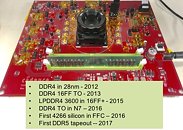Friday, May 4th 2018

Cadence and Micron Demo DDR5-4400 Memory Module
Cadence and Micron have joined forces to build the world's first working DDR5-4400 memory module. Cadence provided their DDR5 memory controller and PHY for the prototype while Micron produced the 8 Gb chips, which were manufactured under TSMC's 7 nm process. They were able to achieve 4400 megatransfers per second, which is roughly 37.5% faster than the fastest DDR4 memory that is currently on the market. Nevertheless, Marc Greenberg from Cadence emphasized that DDR5 aims to provide increased capacity solutions, more than actual performance.
The DDR5 standard should facilitate the production of 16 Gb dies and make vertical stacking easier. Restricted by laws of physics, dies eventually get slower as they increased in size. Once you start putting 16Gb die in 1X memory technology, the distances between them starts to get longer. As a result, core timing parameters become worse. Cadence's prototype had a CAS latency of 42 (No, not a typo). Although, the test module does run at 1.1 volts, which makes it quite impressive when compared to DDR4.Cadence expect DDR5-4400 to be the standard for DDR5 with DDR5-6400 coming later down the line. According to their analysis, we could see DDR5-based systems as soon as in 2019. However, they'll most likely be servers. The process of DDR5 adoption will be gradual and steady until 2021 when it starts to really ramp up. It's important to point out that the DDR5 standard isn't completed yet. JEDEC won't finalize the specifications for DDR5 until sometime this summer. Having being the first with IP for DDR5, Cadence already has its eyes set on LPDDR5 and HBM.
Source:
Cadence
The DDR5 standard should facilitate the production of 16 Gb dies and make vertical stacking easier. Restricted by laws of physics, dies eventually get slower as they increased in size. Once you start putting 16Gb die in 1X memory technology, the distances between them starts to get longer. As a result, core timing parameters become worse. Cadence's prototype had a CAS latency of 42 (No, not a typo). Although, the test module does run at 1.1 volts, which makes it quite impressive when compared to DDR4.Cadence expect DDR5-4400 to be the standard for DDR5 with DDR5-6400 coming later down the line. According to their analysis, we could see DDR5-based systems as soon as in 2019. However, they'll most likely be servers. The process of DDR5 adoption will be gradual and steady until 2021 when it starts to really ramp up. It's important to point out that the DDR5 standard isn't completed yet. JEDEC won't finalize the specifications for DDR5 until sometime this summer. Having being the first with IP for DDR5, Cadence already has its eyes set on LPDDR5 and HBM.


35 Comments on Cadence and Micron Demo DDR5-4400 Memory Module
I switched to DDR4 about 1½yrs ago and I plan to go with this for some years. Like on my past with computer memory
SDRAM from my PC hobby beginning to 2006
DDR1 from 2006 to 2008
DDR2 from 2008 to 2011
DDR3 from 2011 to 2016
Do you know how many times that has happened in the past?
Zero.
I imagine some work loads are far more sensitive to latency then others, where bandwidth rules.
EDITI'm a bit confused here: isn't AM4 platform supposed to last until 2020? That means i can buy a RyZen CPU in 2 years time and stick it in my current board (AsRock Taichi) and it should work with, more than likely, BIOS updates.
That said, you'll lose out on any newer chipset / RAM / something else improvements that go "hand in hand" with the newer generations, meaning you won't be able to take full advantage of the CPU but will have most of it.
For example: with my TaiChi X370, i can run a 2700X CPU just fine, but i won't have precision overdride that X470 has.
Two sockets, AM2 and AM3 but the cpu can be interchanged.
Also CAS timings CL42. Ouch. For comparison DDR4 does 4400 at CL18-CL19. First DDR5 is going to be slower than best DDR4 at the moment. Hell best DDR4 sticks already ship with 4600-4700Mhz and go to 5000Mhz best case.
DDR5 is more about capacity not speed.
DDR4 already feels like a new tech and they're pushing already a better memory standard? But well, who forces me to upgrade from my 7700K..?
I might have to sell multiple :laugh:
DDR-333 @ CL2,5 / DDR-400 @ CL3
DDR2-667 @ CL5 / DDR2-800 @ CL5
DDR3-1066 @ CL7 / DDR3-1600 @ CL11
DDR4-2133 @ CL16 / DDR4-2133 @ CL16
Essentially the JEDEC baseline speed has always doubled (except from DDR2 to DDR3 but you could argue that 1333Mhz was DDR3 baseline) and if DDR5 starts from 4400Mhz it is in line with 2133x2. Even a litte over it.
However the progress has slowed down:
DDR1 2000
DDR2 2003
DDR3 2007
DDR4 2014
3 years, 4 years, 7 years and currently 4+ years.
Such innovation :eek:
Much wow :rolleyes: